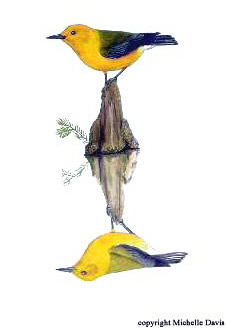RESEARCH ACTIVITY
BANDING COMPONENT – The Migratory Bird Research Group has been banding at this site since 2008, and
Kristina Paxton has conducted research at the site since 2003. During spring migration (March – May), 15 mist-nets are operate daily at the site, capturing about 1,600 birds per season and 60 different bird species.
Click here for a table of all birds banding at the Cibola NWR banding station in the spring of 2008.
MIGRATORY CONNECTIVITY – Kristina Paxton’s research focuses on identifying the breeding destination of Wilson’s Warblers (Wilsonia pusilla) captured at the migration banding station. Integration of information from stable isotopes, genetic markers, and plumage coloration allows us to geographically link
individual Wilson’s warblers captured at the stopover site with their breeding area destinations. Thus, for each Wilson’s warbler captured, a tail feather is pulled for stable hydrogen isotope analysis, a blood sample via brachial vein is collected for genetic sample, and plumage coloration measures are taken with a colorimeter.
MIGRATION STRATEGIES – By identifying the breeding destination of Wilson’s warblers captured during migration we can assess (1) how far migrants must travel from the stopover site to their breeding area and (2) whether migrants are early or late relative to other birds traveling to the same breeding area. This allows us to examine how differences in the distance to a breeding area destination may affect migration stopover strategies such as stopover duration, fuel deposition rates, and foraging behavior.
|
